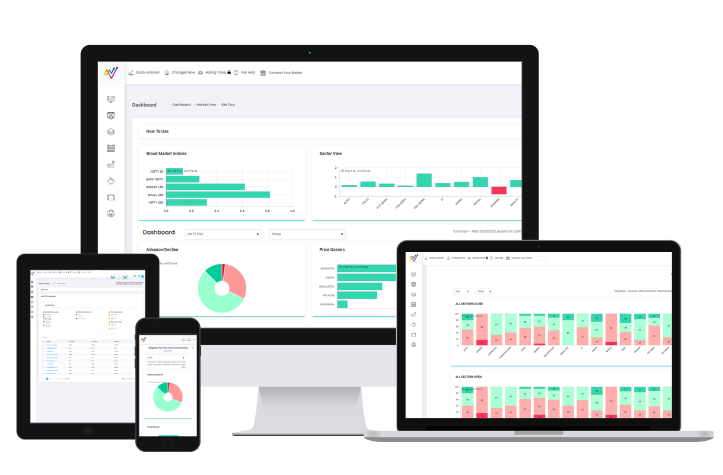
NeoTrader and the Rise of Smart Swing Trading Strategies
Explore how NeoTrader is transforming swing trading with AI-powered insights, smart charting, and data-driven strategies. Learn how traders can maximize returns while minimizing risks.
The investing and trading world is much like driving on the road. What do we find while we are out on the road? We mostly moderate our driving in line with the way others are driving. If other cars are moving fast then we tend to move faster; if others are going at a sedate pace, so do we. If others observe a signal, we tend to do so. But when a few cars over run a signal- and there is no cop around- we tend to follow suit and break that signal too, even though we may really not want to. We have a built in sense of what is too fast or bit reckless and don’t take undue risk.
The "rise" of smart swing trading strategies is fuelled by their ability to provide a balanced approach to trading, offering flexibility and potential for higher gains than day trading by holding positions for a few days to weeks while capturing significant price swings, all facilitated by modern technical analysis tools and platforms.
Unlike day trading, swing trading aims to profit from short-to-medium-term price fluctuations, holding positions for a few days to several weeks. The goal is to identify and exploit "swings" upward or downward movements in price – within a larger trend, buying low and selling high. Traders use tools like moving averages, Fibonacci retracements, and oscillators to find trends and determine entry/exit points.
Swing traders don't need to monitor the market constantly, offering more flexibility and time for analysis compared to day traders. Holding positions for longer periods results in fewer transactions, leading to lower trading fees, commissions, and taxes. Holding positions for days or weeks can allow traders to capture larger price moves than day trading, potentially leading to higher profits per trade. swing traders often use stop-loss orders to limit potential losses and are less prone to overtrading, which can drain capital.
Key Smart Swing Trading Strategies - Breakout Strategy, Pullback Strategy, Momentum Strategy, Trend Following, Support and Resistance
Trading and Investing is a thinking man’s game. While it is true that it is the faulty thinking that can get you into trouble, it is also true that the same thinking when righted, can lead to the riches that we all know is there in the markets.
NeoTrader & the Future of Option Trading: What’s Shaping 2025?
The very basic point that is overlooked is that Options are not linear instruments like futures and equities. Most people are habituated to think in terms of directionality when trading the markets. Options are a different asset class that have many other variables attached to them compared to futures. One major difference being Time. Options are wasting assets unlike futures. Time erodes the value of options but it does not do so for futures. Most new option traders don’t understand this fact and most of them are substituting cheap option plays for futures.
Futures (and stock) are not whittled by time whereas an option contract is. But rather than fork out a few lacs as margin for the future, the ignorant option trader believes that he can achieve the same result by trading long options. And here, he compounds the error by taking a position in Out of the money options. Unless luck favors this trader, the only outcome of this approach is a loss.
This brings us to shorting options. Today the great belief is that those that short options make money, maybe lots of it. Twitter has now become a popular playground for those who want to flaunt their shorting skills. It is now common to read about 7 or 8 figure incomes made by random youngsters. No one knows the veracity of these claims but they do abound because the market is a sucker for such success stories and people lap them up.
Unfortunately, what these stories do is to create a hype around option trading where it has now almost become fashionable to say that you are an options trader and play the short side! So, as soon as any trader can drum up some capital, he quickly moves to shorting options. Most of them, sadly, end up losing their shirt.
Does that mean there is no money in shorting options either? Not really. Two aspects to be looked at here. But before that, a slight aside. Insurance companies (when they sell you policies) are actually selling you an option. You as the Insured, pay a premium. If you pause to think, some of the biggest buildings (all across the world) are Insurance company buildings! Can that just be a coincidence? In one or two places, yes. But all over the world? No chance.
This means that there is definitely money to be made in selling options. But the key here is to manage the risks properly. Just think about the Insurance companies once again. Don’t they have a hundred check points for whom they will sell the policy to? Don’t they, most of the time, go after the low hanging fruit? Are they not in control, almost, all of the time?
Now, if you come back to the option trader, is he or she really applying any risk control strategies? Do most of them even know how? I would wager a very large sum of money that they don’t. This is especially magnified when they short options. When you don’t know how to manage an option trade, the result is often a loss.
The typical story is one of making a series of profits (small ones) and then one day getting blown out of the water with an outsized move that triggers a sharp rise in implied volatility. When time is also a factor in this equation (as happens on Expiry days), the impact is far greater. One of the popular plays every week is Zero to Hero trades. Most of them end as Zeros. But people play them, without fail, every week. Hope is the biggest strategy employed by a vast majority of option traders.
And here is where it gets more complicated & dangerous. Technology now pervades this line so much that a very large percentage of trades are being done thru automation. It is therefore impossible for the lay trader to try and compete (in execution) with the machine. Co-located servers ensure that the rates that you see on your screen are much delayed and hence the fills you get are quite far from where you plan. The machines are running multiple algos and your small trade gets caught in the middle of one of them. Chances of you winning are therefore very slim. The big players have giant capital deployed while you have very limited capital. They have complex algos, designed by PhDs running on fast machines whereas you have no training and no skill sets and no execution advantages.
You can see that you don’t really stand a chance.
So, am I suggesting that one should not engage in playing long or short in options? Again, not really. There is a good deal of money to be made in options. But there are some basic requirements that cannot and should not be ignored.
What everyone who is interested in options trading needs to do is
-
•Get an education first. Learn the details and intricacies of the instrument before you trade.•Get capital. Your 10000 bucks is going to disappear in a week (if you are lucky). Don’t even dream of playing the Derivative markets if you have no capital.•Get good execution. I don’t mean co-locate a server (you cannot afford to) but you should not have any impediment to swift execution.•Know thoroughly when long options will work and when short options will work better. This will make a huge difference in the way you play and succeed.•Your education must include a detailed knowledge on how to manage your trades, specially the shorts. So, a few YouTube videos of ‘training’ is NOT going to do it.•Work alongside a mentor if possible, watching him place trades and manage them to conclusion. Ask him the logic and absorb. Then venture out on your own.•Forget the Telegram channel vendors who inundate you with trade recons and don’t bother with the 20 min YouTube video that promises you a ‘No Loss’ super strategy that you can deploy every day at 9.20 am and reap your rewards at 3 pm. These are just chimera.
I have tried to paint a holistic picture of the growth and current status of the options markets in India. Some sensible paths have been shown. Hopefully, the number of people losing money in the options markets would have reduced.







